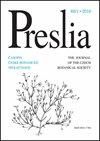Cytogeography of invasive knotweeds (Fallopia sect. Reynoutria) in central Europe
IF 2.9
2区 生物学
Q1 PLANT SCIENCES
引用次数: 1
Abstract
Fallopia sect. Reynoutria members (knotweeds) represent one of the most invasive alien plants in Europe. However, several aspects of their biology, including cytological variation are poorly understood. Specifically, some taxa have multiple ploidy levels and the frequency of cytotypes in seeds and seedlings does not correspond to that recorded in adult plants. In this study, flow cytometry was used to determine the relative genome size of 1,106 established plants of knotweeds (960 populations) collected in the Western Carpathians and adjacent area in Pannonia, and the results were combined with previous data (53 individuals from 43 populations) from the Krivánska Malá Fatra Mts. In total, 1,159 individuals from 1,003 populations (825 individuals from Slovakia, 173 from Hungary, 70 from Poland, 63 from Czechia and 28 from Austria) were evaluated. Fallopia sect. Reynoutria is represented mainly by the hexaploid (2n = 6x ~ 66) cytotype of F. ×bohemica (809 individuals) and octoploid (2n = 8x ~ 88) cytotype of F. japonica var. japonica (297 individuals) in the area studied. To a limited extent, the tetraploid (2n = 4x ~ 44) and hexaploid (2n = 6x ~ 66) cytotypes of F. sachalinensis (43 and 9 individuals, respectively) were also recorded. In addition, for the first time, adult aneuploid knotweed plants with 2n = 65 and 2n = 107 chromosomes (both in F. ×bohemica) were recorded in continental Europe and the world, respectively. In contrast, the occurrence of the tetraploid (2n = 4x ~ 44) cytotype of F. japonica previously reported in the area studied was not confirmed and it is likely this information is incorrect. This study revealed evidence of a climatically determined distribution of invasive knotweeds in the area studied. The occurrence of F. japonica var. japonica and F. sachalinensis decreased markedly along a north-west–south-east gradient, whereas the frequency of F. ×bohemica occurrence increased (from 15.7% in the Polish part of the Western Carpathians up to 98.5% in the Hungarian part of Pannonia).入侵欧洲中部结缕草属植物的细胞地理学
落叶属植物(Fallopia)是欧洲入侵最严重的外来植物之一。然而,其生物学的几个方面,包括细胞学变异,了解甚少。具体而言,一些分类群具有多个倍性水平,种子和幼苗的细胞型频率与成年植物的记录不一致。本研究利用流式细胞术测定了在Pannonia西部喀尔巴阡山脉及其邻近地区收集的1,106株结缕子属植物(960个种群)的相对基因组大小,并将结果与先前在Krivánska mal Fatra Mts收集的43个种群53个个体的数据相结合,共评估了1,003个种群的1,159个个体(其中斯洛伐克825个,匈牙利173个,波兰70个,捷克63个,奥地利28个)。研究区黄叶属植物主要以黄叶属×bohemica(809株)的六倍体(2n = 6x ~ 66)细胞型和黄叶属japonica变种(297株)的八倍体(2n = 8x ~ 88)细胞型为代表。在一定程度上,还记录到了沙沙林赤杨的四倍体(2n = 4x ~ 44)和六倍体(2n = 6x ~ 66)细胞型(分别为43和9个)。此外,还首次在欧洲大陆和世界范围内分别发现了2n = 65和2n = 107染色体(均为F. ×bohemica)的非整倍体结缕草成虫。相比之下,先前在研究区域报道的粳稻四倍体(2n = 4x ~ 44)细胞型的出现没有得到证实,可能是不正确的。这项研究揭示了气候决定的证据入侵节草分布在研究地区。沿西北-东南方向,日本品种和萨沙林赤霉病的发生频率明显减少,而×bohemica赤霉病的发生频率则增加(从西喀尔巴阡山脉波兰地区的15.7%增加到潘诺尼亚匈牙利地区的98.5%)。
本文章由计算机程序翻译,如有差异,请以英文原文为准。
求助全文
约1分钟内获得全文
求助全文
来源期刊

Preslia
生物-植物科学
CiteScore
5.20
自引率
29.40%
发文量
8
审稿时长
>12 weeks
期刊介绍:
Preslia is a peer-reviewed scientific journal publishing original research papers on plant systematics, morphology, phytogeography, ecology and vegetation science, with a geographical focus on central Europe. The journal was founded in 1914 and named in honour of brothers Jan Svatopluk Presl (1791–1849) and Karel Bořivoj Presl (1794–1852), outstanding Bohemian botanists. It is published quarterly by the Czech Botanical Society.
 求助内容:
求助内容: 应助结果提醒方式:
应助结果提醒方式:


